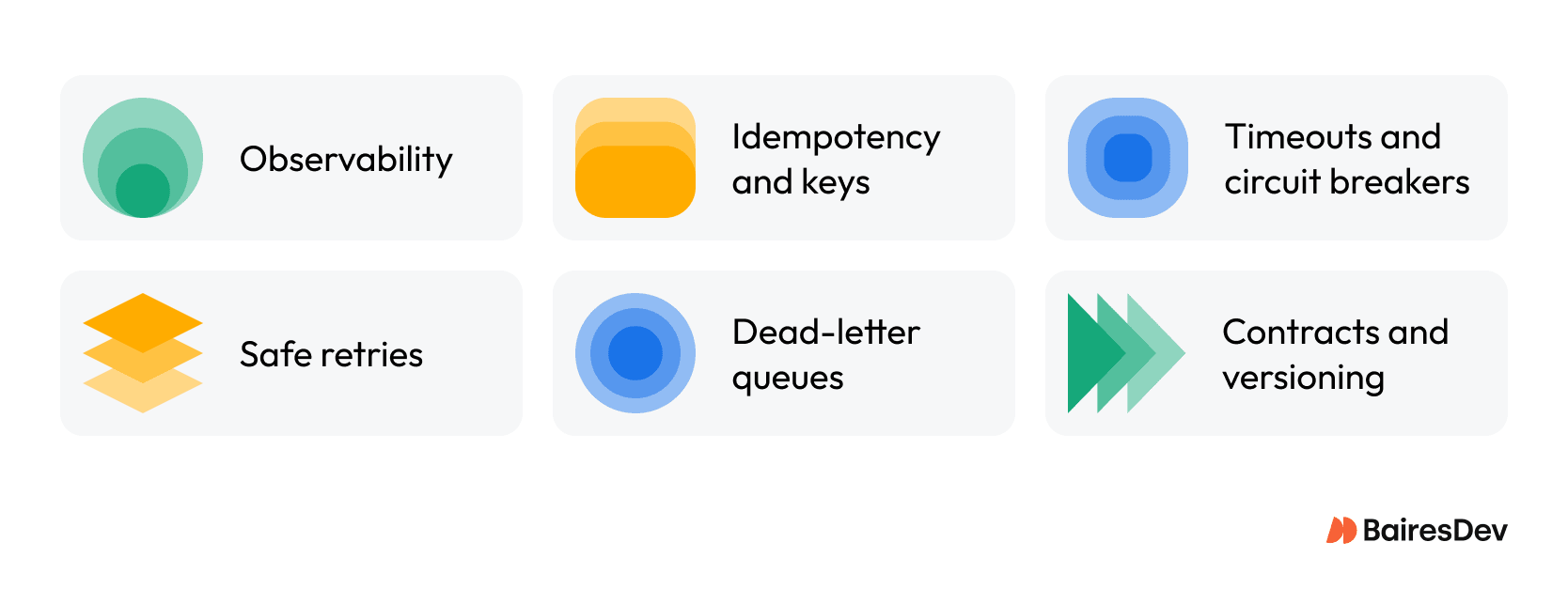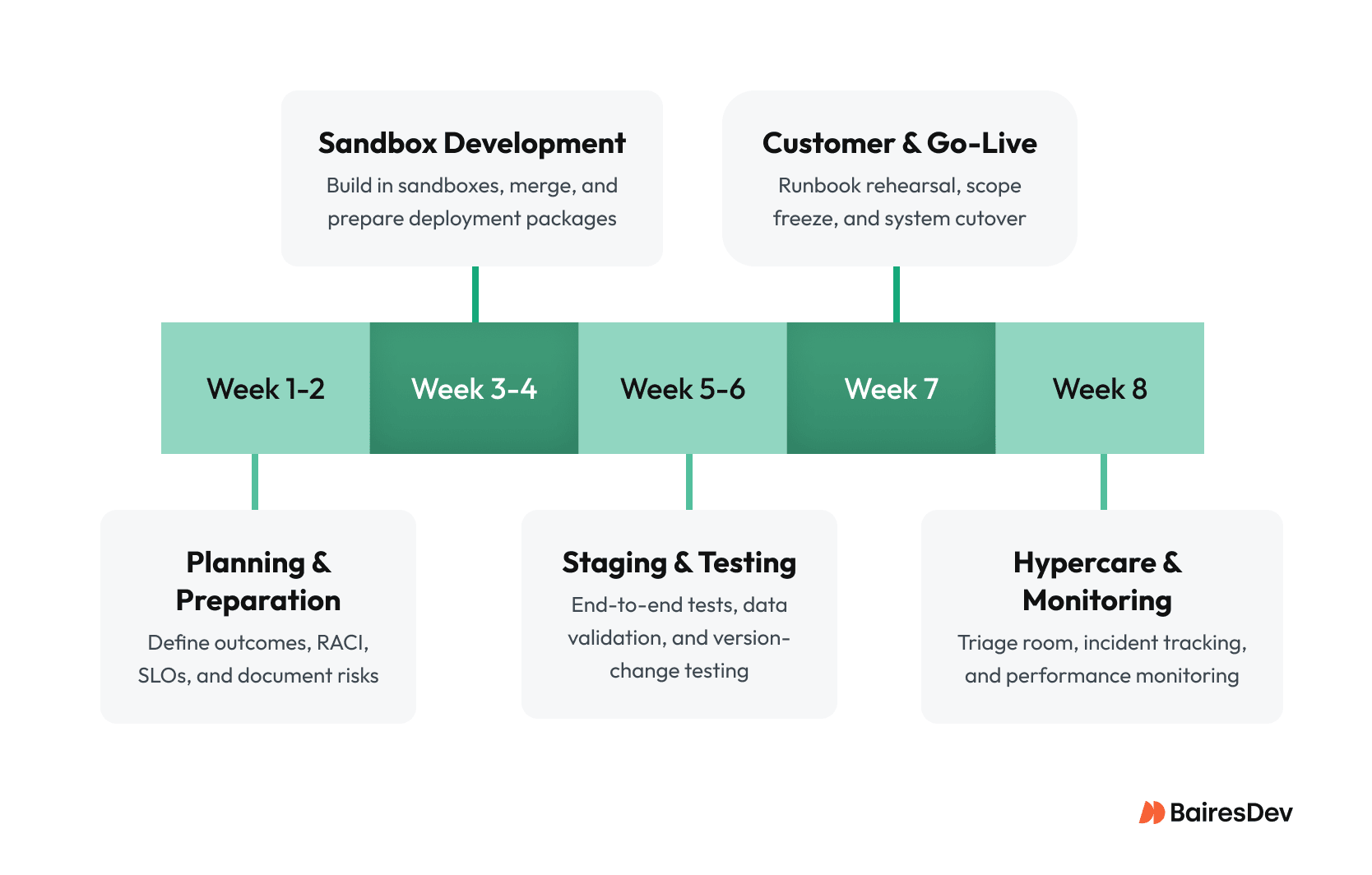NetSuite projects fail when engineers treat them like IT tickets instead of a product release. You end up with month-end surprises and broken integrations. It all comes down to weak ownership.
This guide covers NetSuite ERP implementation from an engineering perspective: integration architecture, data migration, testing strategy, and cutover execution. It includes a downloadable cutover runbook and RACI checklist.
Engineering Ownership Safeguards NetSuite Delivery
Engineering ownership is what makes or breaks a NetSuite project. It’s that simple. When your team owns the SDLC, the environments, and the change gates—releases are predictable. Data is accurate. Uptime holds.You also recover faster when trouble hits.
NetSuite implementation projects often falter when they are run as side projects. To avoid that, run NetSuite like a product engineering team. Set coding standards, branching, reviews, and automated tests for SuiteScript 2.x and SuiteFlow. Push every change through a controlled pipeline across sandbox, staging, and production, not one-off admin actions.
Ownership gaps create risk during close. Engineers should manage configurations as code, store secrets in a secure vault, and enforce role-based access controls for admins and service accounts. Require release gates with test evidence, rollback steps, and data impact notes. Use a joint CAB with finance and freeze near close.
A layered design contains failures and speeds up recovery. Model data with configuration, route simple flows in SuiteFlow, and reserve SuiteScript for business logic. Publish versioned APIs with clear error contracts. Monitor dashboards keyed to order, invoice, and payment IDs, so you can connect incidents to their corresponding business impact.
Operations decide whether delivery sticks. Rehearse end-to-end flows with production-like data. Track timings, failure points, and owners. Promote only when tests pass and rollback succeeds. After go-live, run hypercare with an engineering-led triage room and SLOs tied to cash flow, posting time, and error rates.
Integration Architecture That Fails Safely
Safe NetSuite integrations expect errors and recover fast.
You must design for timeouts, safe retries, and handling of duplicates. Use clear contracts, idempotent endpoints, and monitored queues. Respect the NetSuite platform limits so that posting, fulfillment, and invoicing continue when partners slow down or fail.

- Idempotency and keys: Use a stable external identifier on each create, such as orderId or invoiceId. On retry, return the prior result instead of posting a duplicate.
- Timeouts and circuit breakers: Set strict connect and request timeouts. On repeated failures, open a middleware circuit breaker, queue work, and pause partner calls until healthy.
- Safe retries: Retry only transient errors, such as 429 or timeouts. Use exponential backoff with jitter and cap attempts.
- Dead-letter queues and replay: When a message fails several times, move it to a DLQ with full context. After you fix the cause, replay safely so no records are lost or double-posted.
- Contracts and schema versioning: Include explicit version fields and enforce consumer-driven contract tests in CI. Block breaking changes without an agreed migration plan.
- Observability tied to finance outcomes: Correlate logs and traces by order, invoice, and payment IDs. Dashboard queue depth, failed postings, book-to-bill time, and alert on sustained breaches.
NetSuite Implementation Environments and SDLC
Strong environment boundaries and a lean SDLC keep your NetSuite rollout safe.
When each stage has a purpose and promotion rules, errors surface early, releases move predictably, and finance stays productive. Your goal is clarity from build to hypercare.
In practice, define your development, sandbox, staging, and production environments with strict promotion rules in place. Shorter release trains reduce drift. Tests precede approvals. You rehearse cutover. The goal is to implement NetSuite with minimal risk, while your teams in finance and operations continue to work.
Work flows better when your NetSuite environments map to work, not people. Personal sandboxes support builds and unit tests. A shared integration sandbox runs early end-to-end checks. Staging mirrors production for release candidates. Production changes move only through the pipeline with monitoring, alerting, and verified rollback. Release Preview validates version changes before go-live.
Implementation quality improves when your changes ship as packages. Use SuiteCloud Development Framework to version changes and deploy through a controlled pipeline. Run SDLC with a clear branch strategy, pull requests, and required reviews. For SuiteScript 2.x User Event, RESTlet, and Map/Reduce scripts, gate merges on static checks, unit tests, and integration tests, then promotes with SDF packages, not admin clicks.
Visibility comes from crisp entry and exit criteria for every environment. Staging uses production-like data, cutover is rehearsed, and rollback is verified. When Release Preview has limits, move those tests to the sandbox to maintain strong coverage.
Metrics keep the loop closed. Use SuiteAnalytics Workbook for posting rates, queue age, and timing targets. Keep Saved Searches for exception views and audit trails, and pin critical searches to portlets for daily monitoring. Prepare each SDF project with a clean deploy.xml and a documented order of operations so promotions are repeatable and rollbacks fast.
NetSuite Program Plan and Timeline
Every leader needs calendar certainty to align finance, operations, and vendors.
A fixed eight-week schedule with published dates, owners, and exit criteria for the environment maintains stability in the scope. You rehearse cutover, verify rollback, and set stop rules so that defects surface early and deadlines are met.

- Weeks one and two: Confirm outcomes and data impacts. Define environment entry and exit criteria, RACI, and SLO targets. Record risks and owners in the runbook.
- Weeks three and four: Build in NetSuite Sandboxes, then merge to the integration sandbox for early end-to-end checks. Prepare SuiteCloud Development Framework packages for staging and document the promotion path.
- Weeks five and six: In staging, run end-to-end tests of core business processes with production-like data. Validate accounting and posting metrics with SuiteAnalytics Workbook and Saved Searches. Use Release Preview for version-change testing and shift unsupported items back to sandbox.
- Week seven: Rehearse the runbook, verify rollback steps, and freeze scope. Execute cutover in a planned window. Validate integrations, balances, and postings before opening for business.
- Week eight: Operate an engineering-led triage room with clear queues and owners. Track incidents, MTTR, and posting success using SuiteAnalytics Workbook and key Saved Searches. Exit hypercare when targets hold.
NetSuite Implementation Roles, Access, and Auditability
Without clear roles and access control boundaries, NetSuite projects can expose more risk and hinder audit cycles.
You should define who is responsible for what across business processes, limit permissions with least privilege, and keep evidence readily available. Clear models and reliable logs help safeguard your data, facilitating both external and internal reviews.
You move faster when roles match real work. NetSuite roles bundle permissions, pages, and tasks by function. Copy standard roles, tailor them as needed, and link each to the corresponding centers so your teams stay productive without overexposure.
Risk decreases when permission design adheres to the principle of least privilege. Build a role matrix to set permission levels and prevent risky combinations. Confirm how the record, task, and page access map to each role before granting exceptions.
Your audits will run more smoothly when every change is accompanied by context. System notes record who changed what, when, and whether updates came from UI, SuiteScript, or web services. Predefined audit trails aggregate these notes for common records, facilitating faster reviews. Monitor and report with native analytics, then implement these controls:
- Roles model: Define standard roles for finance, operations, and support, then clone and narrow as needed. Tie each role to the minimum permissions required and keep administrator actions out of daily work.
- Segregation of duties: Separate initiating, approving, and posting activities. Use permission levels to prevent risky combinations, then validate with a permission matrix so exceptions are deliberate and documented. Keep the matrix under change control.
- Evidence and logging: Use predefined audit trails and system notes to track edits and approvals, including context for UI, SuiteScript, or web services updates. Add Saved Searches for access changes and export events, using execution logs and audit history.
- Reporting: Build SuiteAnalytics Workbooks that show who can post, who approved, and how often exceptions occur. Share read-only views to reduce back-and-forth and keep reviews in product, not spreadsheets.
NetSuite Data Migration Without Surprises
Data migration surprises surface when the scope drifts, record dependencies are missed, or posting rules change in transit.
NetSuite enforces parent-child order, currencies, and tax logic that differ from source systems. Governance limits and Release Preview gaps add friction. You need proofs at each step so errors appear early, not during close.
To make the work predictable, anchor your migration plan with scope and evidence. Move the data that supports reporting and operations, then reconcile every load. You define owners, run repeatable jobs, and verify source to NetSuite before and after go-live. With evidence in hand, finance stays confident through close and audit.

Start with scope, not tools. Select years to migrate, open items to carry, and history to archive. Confirm dependencies, customers before invoices, items before transactions, vendors before bills. Map each field to one source of truth and document the rules. Model the target first. Define subsidiaries, currencies, and accounting books. Set rules for rounding, exchange rates, and tax, then write transformations as a shared playbook.
Build repeatable extraction and load paths. Use the CSV Import Assistant for master data and high-volume loads. Use SuiteScript 2.x Map/Reduce or REST Web Services for transactional or conditional logic. Keep files small, batch by record type, size runs for governance limits, and log every record with an external ID.
Prove integrity as you go. Validate links and required fields before loading. After each trial conversion, use Saved Searches and SuiteAnalytics Workbook to compare counts, amounts, and aging across systems. Reconcile inventory quantities and valuations when items, lots, or serials are in scope.
Treat trial conversions like releases. Run at least two full rehearsals in a sandbox, timing each step. Capture failures with owners, track fixes, and keep the runbook current with inputs, outputs, and stop rules. Promote to staging only when checks pass and rollback works.
Handle transactions with care. Decide whether to migrate detailed history or summarized balances. For open invoices, payments, and credits, carry statuses and dates needed for reporting. For orders and fulfillments, align posting periods and approve steps in the correct sequence.
Cutover is about control, not speed. Freeze source changes, snapshot final balances, and run the T-0 load. Lock the posting period, post control entries, reconcile again, and keep a replay path for failed records. Roll back if thresholds break. Use this checklist to lock scope, load safely, and prove results:
- Data scope and owners: List entities, time range, and open items. Name the engineering and finance approvers.
- Load strategy: Use CSV Import for master data, SuiteScript 2.x or REST for logic-intensive loads. Batch to respect limits and monitor progress.
- Reconciliation: Compare counts and amounts with Saved Searches and SuiteAnalytics Workbook. Retain evidence for audits.
- Cutover controls: Freeze, load, reconcile, open. Keep rollback and replay ready.
NetSuite Testing Strategy and Go/No Go
Engineering leaders need one clear decision point backed by evidence, not opinions.
A structured NetSuite testing strategy defines layers, data, gates, and artifacts across environments. With fixed entry and exit criteria, the risk to close, billing, and fulfillment remains low, releases stay predictable, and audits proceed more efficiently.
Your test layers should mirror business flows. Unit tests validate SuiteScript 2.x functions and errors. Integration tests cover RESTlets, workflows, and partner calls in fakes or sandboxes. System tests exercise order-to-cash, procure-to-pay, and record-to-report in isolated accounts.
Your results stay credible when the test data is stable. Create reusable datasets for customers, items, tax, subsidiaries, and currencies. Seed known IDs, document refresh steps, and reset secrets so runs stay consistent. Use Release Preview for version-change testing. When a sandbox refresh occurs, notify owners, re-enable integrations, and reseed data.
You gain speed when you automate the essentials. Run a small regression pack on every change. Include API contract checks, key workflow paths, and error handling. Track timings for posting, search latency, and queue age, then store artifacts with the build.
Objective gates remove debate and focus your teams. Integration requires unit and API checks to pass. Staging requires end-to-end scenarios, reconciliations, and performance baselines. UAT requires role-based tasks completed by named users. Fix Sev-1 and Sev-2 before moving forward. Defer only low-risk items with a documented workaround and an owner. Capture evidence as Saved Searches, SuiteAnalytics Workbook views, and test reports attached to the release.
Use this checklist to make a clear, defensible decision (confirm each item with evidence and record the name of the approver):
- Blocking defects: Zero Sev-1 and Sev-2. Any Sev-3 deferred with a documented workaround and owner.
- Data checks: Reconciliations for counts and amounts match targets, including edge cases.
- Performance: Posting, search, and integration timings meet baselines under expected load.
- Evidence package: Test results, approvals, and rollback steps attached to the release.
- Release readiness: On-call rosters, runbook links, and communications prepared for cutover.
NetSuite Cutover Runbook and RACI Checklist
Use this one-page runbook and RACI to run a controlled NetSuite cutover. Follow the gates, execute tasks, record evidence, and capture approvals. The T-3 to T+7 timeline establishes expectations for data loads, integration switch, business open, and hypercare.
Name a cutover manager with stop-call authority. Define acceptance limits, list backout triggers, and assign owners and backups. Replace bracketed fields, schedule the window, and document each gate outcome with links to proof. If your team partners with external NetSuite implementation services, include vendor contacts and escalation paths in the RACI.
Download: Cutover Runbook & RACI Checklist
User Training and Adoption
Train by role and task. Provide short guides and checklists, require proof of completion, and run office hours during T-0 and T+1. Measure adoption with Saved Searches and SuiteAnalytics Workbook, then unblock issues fast. Keep updates brief, targeted, and tied to order-to-cash and procure-to-pay.
Ongoing Support to Steady State
Operate an engineering-led triage room through T+7. Use one intake path, triage by severity and customer impact, and hold a short daily standup. Enforce SLOs, freeze non-critical changes, and replay DLQ items only after fixes have been implemented. Exit hypercare when targets hold and finance confirms close readiness.
Project Team Roles and Communications Cadence
Make RACI explicit. Run a bridge call during cutover and a daily hypercare standup. Send one executive update with the current state, risks, and next steps. Route partner updates through the integration lead. Publish an escalation matrix, and record each gate decision with linked evidence.
NetSuite Implementation Metrics That Matter
Implementation metrics matter when they predict cash flow, stability, and audit readiness. When your NetSuite dashboard tracks outcomes, not activity, you see regressions early. Signals that tie orders, invoices, and postings to risk help your teams correct course before period close slips or customers notice.
Your dashboards earn their keep when every trend has an owner, target, and deadline. Publish daily SuiteAnalytics Workbook views and Saved Searches, then act when a metric drifts. The list below focuses on outcomes that move cash and stability, turning trends into fixes instead of reports.
Use the following set of example metrics to spot risk early and act quickly (review the results daily, assign owners, and turn trends into fixes, not reports):
- Book-to-bill time: Measure from order creation to invoice posting using a Saved Search join and a Workbook percentile view. Alert on sustained P95 breaches.
- Invoice posting success: Track the daily invoice failure rate with a Saved Search filtered by status, and chart it in Workbook. Require DLQ replay within a fixed window and store evidence with the release.
- Reconciliation completeness: Compare counts and amounts for migrated or daily loaded data using paired Workbooks or Searches, then attach results to the release record. Keep variances as audit evidence.
- Integration queue depth and age: Surface backlog and message age from custom queue records or script logs in a Saved Search, and trend in Workbook. Set thresholds that trigger scaling or backoff.
- Sev-1/Sev-2 MTTR: Record incidents on Issue or Case records with created, acknowledged, and resolved timestamps, then compute MTTR in Workbook. Include root cause and fix notes.
- Close readiness time: Track tasks from the Period Close Checklist with Searches, then measure hours from period end to ready to close. Escalate when postings, approvals, or reconciliations block the target window.






